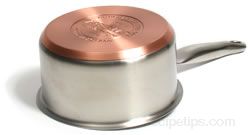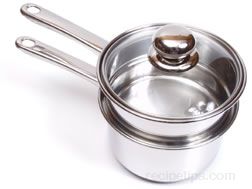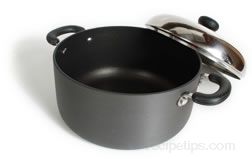KITCHEN PANS - Copper-Bottom Pan to Dutch Oven
COPPER-BOTTOM PAN
 There are many advantages in using copper cookware; some being aesthetic and others
relating to the actual cooking process. Copper bottom cookware is beautiful, especially
when hanging on racks. Many large family kitchens engage in a display of their shiny
bottom copper pots. Commercial restaurants also will hang an array of different
sized copper bottom pots. In both cases, these pots are hung to add to the decorating
beauty of a kitchen, while at the same time adding a feature of convenience. These
factory made pots are made by melting copper onto metal bottoms, making them not
only secure and sturdy, but also easily moved. It saves a lot of time to be able
to select the size of pot that you desire without searching in a cupboard for that
favorite pan. Copper pots sit securely on a stove, making the danger of them tipping
minimal. However, if they are warped they can become a hazard. This can occur when
this appliance is subjected to extremely high temperatures. Since copper is an expensive
metal, many pots have only a bottom of this metal. This reduces the cost, particularly
when copper plates are added to the bottoms of these cheaper metal pots.
There are many advantages in using copper cookware; some being aesthetic and others
relating to the actual cooking process. Copper bottom cookware is beautiful, especially
when hanging on racks. Many large family kitchens engage in a display of their shiny
bottom copper pots. Commercial restaurants also will hang an array of different
sized copper bottom pots. In both cases, these pots are hung to add to the decorating
beauty of a kitchen, while at the same time adding a feature of convenience. These
factory made pots are made by melting copper onto metal bottoms, making them not
only secure and sturdy, but also easily moved. It saves a lot of time to be able
to select the size of pot that you desire without searching in a cupboard for that
favorite pan. Copper pots sit securely on a stove, making the danger of them tipping
minimal. However, if they are warped they can become a hazard. This can occur when
this appliance is subjected to extremely high temperatures. Since copper is an expensive
metal, many pots have only a bottom of this metal. This reduces the cost, particularly
when copper plates are added to the bottoms of these cheaper metal pots.
DOUBLE-BOILER PAN
 When you put a pot on the stovetop, it gets hot – especially the parts of the pot
that make physical contact with the heating element, be it flame or electric coil,
of the stove. When heating something in a pot, the portion that comes in contact
with the very hot bottom of the pan will heat up more quickly than the rest of the
food. This isn’t a problem for most foods, but it is a big problem for some things,
such as chocolate and delicate sauces, that burn very easily. The solution is to
use a double boiler. A double boiler consists of a bowl placed on top of a pan of
simmering water. The bowl does not touch the water, but creates a seal with the
bottom pan to trap the steam produced by the simmering water. The trapped steam
keeps the top bowl going at just about 212F (100C), the temperature at which water
turns to steam and a far lower temperature than could be achieved by putting the
bowl directly on that burner. Inside the top bowl, you can melt chocolate without
worrying that it will stick and burn. You can buy a double boiler, but it’s easy
to make one at home. All you need to make a double boiler is a mixing bowl (preferably
glass/pyrex or metal) and a saucepan that the bowl will fit on top of. The two should
fit tightly together; you don’t want a gap between the bowl and the saucepan, nor
do you want a bowl that sits precariously on a tiny saucepan. To use the double
boiler, add water to the pan and bring it to a simmer, then place the bowl on top
and fill it with whatever you intend to cook or melt.
When you put a pot on the stovetop, it gets hot – especially the parts of the pot
that make physical contact with the heating element, be it flame or electric coil,
of the stove. When heating something in a pot, the portion that comes in contact
with the very hot bottom of the pan will heat up more quickly than the rest of the
food. This isn’t a problem for most foods, but it is a big problem for some things,
such as chocolate and delicate sauces, that burn very easily. The solution is to
use a double boiler. A double boiler consists of a bowl placed on top of a pan of
simmering water. The bowl does not touch the water, but creates a seal with the
bottom pan to trap the steam produced by the simmering water. The trapped steam
keeps the top bowl going at just about 212F (100C), the temperature at which water
turns to steam and a far lower temperature than could be achieved by putting the
bowl directly on that burner. Inside the top bowl, you can melt chocolate without
worrying that it will stick and burn. You can buy a double boiler, but it’s easy
to make one at home. All you need to make a double boiler is a mixing bowl (preferably
glass/pyrex or metal) and a saucepan that the bowl will fit on top of. The two should
fit tightly together; you don’t want a gap between the bowl and the saucepan, nor
do you want a bowl that sits precariously on a tiny saucepan. To use the double
boiler, add water to the pan and bring it to a simmer, then place the bowl on top
and fill it with whatever you intend to cook or melt.
DUTCH OVEN
 Dutch ovens are well suited for long, slow cooking, such as in making roasts, stews,
and casseroles. When cooking over a campfire, it is possible to use old-style lipped
cast iron Dutch ovens as true baking ovens, to prepare biscuits, cakes, breads,
pizzas, and even pies. A smaller baking pan can be placed inside the ovens, used
and replaced with another as the first batch is completed. It is also possible to
stack Dutch ovens on top of each other, conserving the heat that would normally
rise from the hot coals on the top. These stacks can be as high as 5 or 6 pots.
Americans traditionally season their iron Dutch ovens like other cast-iron cookware.
After use Dutch ovens are typically cleaned like other cast iron cookware: with
boiling water and a brush, and no or minimal soap. After the oven has been dried,
it should be given a thin coating of cooking oil to prevent rusting. Again, whether
that should be a vegetable fat or an animal fat (such as lard) is hotly contested.
Saturated fats are more stable than polyunsaturated fats, which tend to go rancid
more quickly. Where possible, a cleaned and freshly oiled Dutch oven should be stored
in a clean, dry location with the lid ajar or off to promote air circulation and
to avoid the smell and taste of rancid oil. If the Dutch oven must be stored with
the lid on, a paper towel or piece of newspaper should be placed inside the oven
to absorb any moisture. With care, after much use the surfaces of the Dutch oven
will become dark black, very smooth and shiny, and as non-stick as the best Teflon
or other non-stick cookware available. With proper care, a Dutch oven will render
decades or centuries of service. Enameled ovens do not need to be seasoned before
use. However, they lose some of the other advantages of bare cast iron. For example,
deep frying is usually not recommended in enameled ovens; the enamel coating is
not able to withstand high heat, and is best suited for water-based cooking. Enameled
ovens can usually be cleaned like ordinary cookware, and some brands can even be
put in the dishwasher.
Dutch ovens are well suited for long, slow cooking, such as in making roasts, stews,
and casseroles. When cooking over a campfire, it is possible to use old-style lipped
cast iron Dutch ovens as true baking ovens, to prepare biscuits, cakes, breads,
pizzas, and even pies. A smaller baking pan can be placed inside the ovens, used
and replaced with another as the first batch is completed. It is also possible to
stack Dutch ovens on top of each other, conserving the heat that would normally
rise from the hot coals on the top. These stacks can be as high as 5 or 6 pots.
Americans traditionally season their iron Dutch ovens like other cast-iron cookware.
After use Dutch ovens are typically cleaned like other cast iron cookware: with
boiling water and a brush, and no or minimal soap. After the oven has been dried,
it should be given a thin coating of cooking oil to prevent rusting. Again, whether
that should be a vegetable fat or an animal fat (such as lard) is hotly contested.
Saturated fats are more stable than polyunsaturated fats, which tend to go rancid
more quickly. Where possible, a cleaned and freshly oiled Dutch oven should be stored
in a clean, dry location with the lid ajar or off to promote air circulation and
to avoid the smell and taste of rancid oil. If the Dutch oven must be stored with
the lid on, a paper towel or piece of newspaper should be placed inside the oven
to absorb any moisture. With care, after much use the surfaces of the Dutch oven
will become dark black, very smooth and shiny, and as non-stick as the best Teflon
or other non-stick cookware available. With proper care, a Dutch oven will render
decades or centuries of service. Enameled ovens do not need to be seasoned before
use. However, they lose some of the other advantages of bare cast iron. For example,
deep frying is usually not recommended in enameled ovens; the enamel coating is
not able to withstand high heat, and is best suited for water-based cooking. Enameled
ovens can usually be cleaned like ordinary cookware, and some brands can even be
put in the dishwasher.
Au Gratin Pan, Broiler Pan, Casserole Pan, Chestnut Pan |
Fondue Pot, Fry Pan, Grill Basket |
Grill Pan, Loaf Pan, Lo-Fat Loaf Pan, Omelet Pan
Paella Pan, Roasting Pan, Roasting Rack, Sauce Pan |
Saucier Pan, Sauté Pan, Sauteuse Pan, Stir-Fry Pan |
Stock Pot, Wok